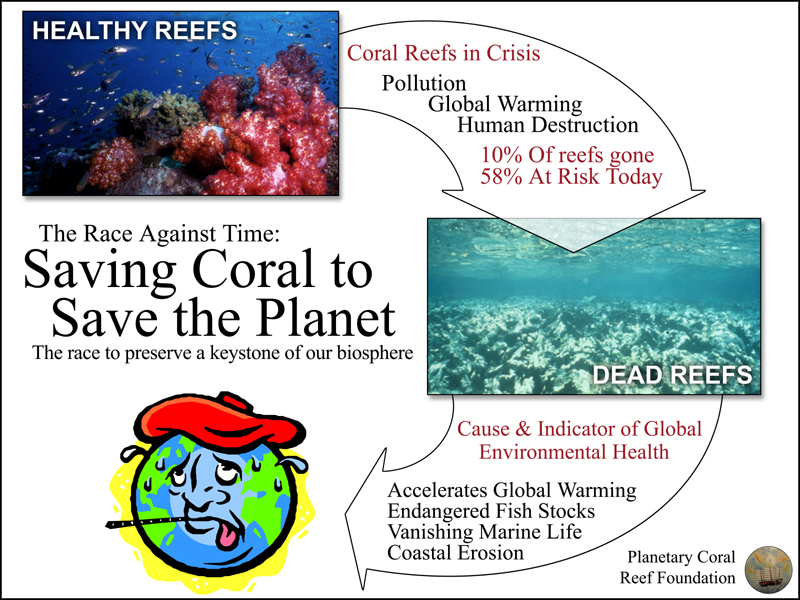| |
The Coral Reef Crisis

Educational Poster Designed by Keenan
Wyrobek & Dan Kranzler
Coral
reefs around the world are dying at an alarming rate. Lining 60,000 miles of shoreline along 109
countries, reefs and their related fisheries, marshlands and lagoons are
vanishing. Home to more than a quarter of all fish species on Earth, an
estimated 25% of coral reefs have already disappeared and an estimated 67% of
all coral reefs are at risk today. In Southeast Asia, 88% of the reefs
are at risk and an estimated more than 90% of the reefs in the Florida Keys have lost
their living coral cover since 1975. In a recent study by the crew
of our research vessel, Heraclitus, 100% of the corals in Kanton Island
lagoon (Phoenix Islands in the remote South Pacific) were observed dead
due to global warming. Threatened by pollution, disease, over-fishing, dynamite and cyanide
fishing, as well as bleaching most likely caused by rising ocean temperatures,
coral reefs are now endangered on a planetary scale.
1
Coral reefs are also an integral part of the earth system
biogeochemical processes, including primary production, carbon and calcium
storage, and geological formations that facilitate water flow and upwelling.
Research has demonstrated that coral reefs respond more quickly than any other
ecosystem to environmental changes - even to the slightest changes in water
temperature - because of their extremely high sensitivity. For this reason,
they are considered an indicator or early warning system for the world's
oceans, and perhaps a 'canary in the coal mine' for all of the other
ecosystems on Earth.
Despite
their importance - both as an ecosystem and barometer for environmental change
- relatively little is known about coral reefs today. Remarkably, there is
no comprehensive global baseline map of living coral reefs. Scientists do not even know the location of many of the world's reefs,
much less their present condition or which species inhabit them. For example, in the Pacific, which has the greatest
concentration of coral reefs in the world, it is estimated that 90% of these
reefs have never been assessed.
1 Given the paucity of data, it is impossible to measure the rate at
which the reefs are disappearing with accuracy. By contrast, scientists know
exactly how much rainforest is left and how much is being destroyed every day
because there is a very detailed rainforest baseline provided by satellite
imagery. A comparable baseline for coral reefs is urgently needed. Until this is
achieved, we will not have the information we need to address the coral reef
crisis on a global scale.
1Reefs At Risk, World
Resources Institute, 1998
|
|










